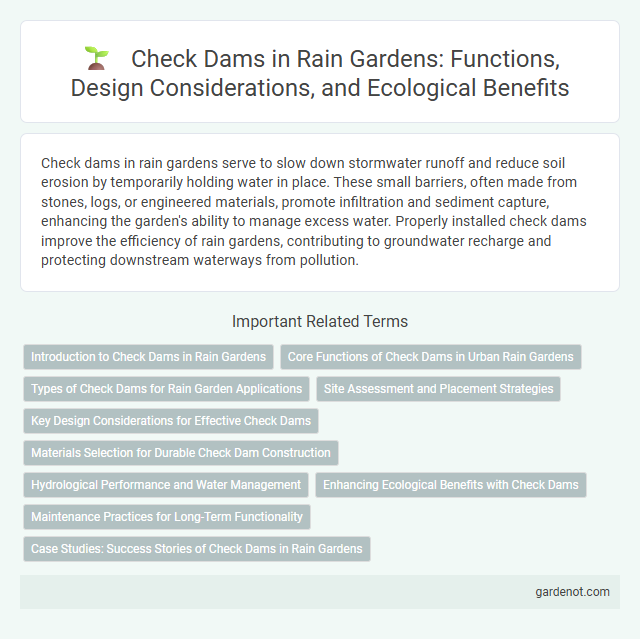Check dams in rain gardens serve to slow down stormwater runoff and reduce soil erosion by temporarily holding water in place. These small barriers, often made from stones, logs, or engineered materials, promote infiltration and sediment capture, enhancing the garden's ability to manage excess water. Properly installed check dams improve the efficiency of rain gardens, contributing to groundwater recharge and protecting downstream waterways from pollution.
Introduction to Check Dams in Rain Gardens
Check dams in rain gardens are small, strategically placed barriers that slow down runoff water, enhancing infiltration and reducing erosion. Constructed from natural materials such as rocks or logs, they help retain sediment and improve water quality by allowing pollutants to settle before water percolates into the soil. These structures optimize rain garden performance by promoting groundwater recharge and protecting downstream ecosystems from excessive sedimentation.
Core Functions of Check Dams in Urban Rain Gardens
Check dams in urban rain gardens primarily slow down stormwater runoff, reducing soil erosion and promoting sediment deposition within the garden bed. By temporarily retaining water, they enhance groundwater recharge and improve water infiltration rates, supporting plant health and soil structure. These functions collectively mitigate urban flooding and filter pollutants, contributing to sustainable stormwater management.
Types of Check Dams for Rain Garden Applications
Types of check dams for rain garden applications include rock check dams, compost check dams, and log check dams, each designed to slow water flow and promote sediment deposition. Rock check dams use durable stones arranged to reduce erosion, while compost check dams utilize organic materials to enhance water infiltration and nutrient cycling. Log check dams employ wooden logs to create natural barriers that support plant growth and stabilize soil within the rain garden system.
Site Assessment and Placement Strategies
Check dams in rain gardens are strategically placed based on thorough site assessment to effectively manage water flow and reduce erosion. Optimal placement involves identifying natural drainage paths, slope gradients, and soil composition to ensure stable installation and maximum water retention. Properly sited check dams enhance sediment capture and promote groundwater recharge, improving overall rain garden performance.
Key Design Considerations for Effective Check Dams
Effective check dams in rain gardens require careful assessment of site slope and soil type to ensure stability and optimal water retention. The height and spacing of check dams must be designed to slow runoff velocity and promote sediment deposition without causing overflow or erosion. Durable materials such as rock or treated wood enhance longevity while allowing easy maintenance and ecological integration.
Materials Selection for Durable Check Dam Construction
Selecting materials such as native stone, treated timber, or recycled concrete ensures durability and environmental compatibility in check dam construction. Permeable materials promote water infiltration and reduce erosion, enhancing the rain garden's effectiveness in stormwater management. Properly chosen materials extend the lifespan of check dams while supporting local ecology and minimizing maintenance needs.
Hydrological Performance and Water Management
Check dams in rain gardens effectively slow surface runoff, enhancing water infiltration and reducing erosion by controlling flow velocity. These structures improve hydrological performance by increasing groundwater recharge and minimizing peak stormwater discharge rates. Incorporating check dams optimizes water management through sediment retention and sustained moisture levels within the soil.
Enhancing Ecological Benefits with Check Dams
Check dams play a crucial role in enhancing ecological benefits within rain gardens by slowing stormwater runoff and promoting groundwater recharge. These small barriers reduce soil erosion and create microhabitats for aquatic and terrestrial species, fostering biodiversity. Incorporating check dams improves sediment retention and nutrient filtration, contributing to healthier riparian ecosystems.
Maintenance Practices for Long-Term Functionality
Regular inspection and removal of sediment buildup in check dams are critical to maintaining optimal water flow and preventing blockages in rain gardens. Vegetation around check dams should be monitored and trimmed to sustain structural integrity and enhance filtration efficiency. Implementing routine maintenance schedules ensures the long-term functionality and durability of check dams within sustainable drainage systems.
Case Studies: Success Stories of Check Dams in Rain Gardens
Check dams in rain gardens effectively reduce soil erosion and enhance water retention, as demonstrated in case studies from urban Maryland and California. These success stories highlight improved groundwater recharge and increased vegetation health due to slowed runoff and sediment capture. Data indicates up to 40% reduction in peak flow rates, validating check dams as a sustainable stormwater management practice.
Check dam Infographic

 gardenot.com
gardenot.com